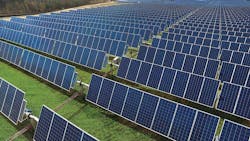Earth Day 2022: The Cloud is Getting Greener, But Much Work Remains
The theme for Earth Day 2022 is “Invest in Our Planet.” Few organizations have invested more in the effort to combat climate change than the leading players in cloud computing, who have spent billions of dollars overhauling how they build, operate and source power for the data centers that power our digital world. But it remains unclear about whether these sustainability initiatives are being adopted by beyond the service provider sector, as surveys show many enterprises are not measuring key indicators of environmental impact.
Data Center Frontier covers the companies, individuals and technologies making data centers more environmentally-friendly. For Earth Day 2022, we’ve compiled our coverage of the industry milestones and trends in sustainability over the past year.
The Cloud Computing Community Confronts Climate Change: As the world confronts the growing urgency of the climate crisis, top cloud computing companies are stepping up their efforts to lead the transition to a cleaner economy. Here’s a look at the next phase of the cloud sector’s climate impact.
Cloud Titans Were the Largest Buyers of Renewable Energy in 2021: The top cloud computing companies accelerated their purchases of renewable energy last year accounting for more than half of all corporate clean energy power purchase agreements in 2021. The data confirms that data center operators are stepping up their sustainability efforts.
Drought, Extreme Heat Sharpen Focus on Data Center Water Usage: Extreme heat and drought in the Western US is bringing sharper scrutiny of data center water use, and testing assumptions about climate in some data center destinations. The heightened awareness of water constraints is raising the bar for data center developers.
Uptime: Most Data Centers Still Not Tracking Environmental Impact: Despite a growing focus on environmental sustainability, most data center operators are still not measuring their water or carbon impact, according to new survey data from Uptime Institute.
Beyond Generators: Data Centers Pursue New Approaches to Backup Energy: What comes next after diesel generators? We dive into the future of backup power, as data center operators are test-driving fuels using vegetable oil and forestry byproducts, fuel cells powered by hydrogen and natural gas, and large lithium-ion batteries.
Corporate Investment and Innovation
In addition to our issue-driven coverage of data centers and sustainability, DCF also highlighted commitments to climate action by individual companies, including the largest hyperscale operators and established leaders in data center equipment. These initiatives highlight investment and innovation by some of the largest players in the sector.
10 Gigawatts: Amazon Hits Milestone in Renewable Energy Purchasing: Newly-announced solar and wind projects bring Amazon’s total renewable energy investments to date to 10 gigawatts (GW), and amplifies the huge role of cloud computing platforms in leading a society-wide transition to renewable energy.
Microsoft Aims to Slash Data Center Water Usage by 95 Percent in 3 Years:Microsoft says it will reduce the use of water in its data centers by 95 percent by 2024 by refining how it designs and operates its massive cloud infrastructure. including operating its data centers at warmer temperatures.
Google to Tap Geothermal Energy for Nevada Data Center Campus: Google will begin using geothermal energy to power its data centers in Nevada with carbon-free energy, teaming with energy startup Fervo to use fiber optic sensors to tap the earth’s own heat to power Google Cloud servers.
Facing Climate Urgency, Facebook Plans to Be Water-Positive by 2030: In response to growing concerns about climate change and data center water usage, Facebook says it intends to be water positive by 2030, meaning it will return more water to the environment than it consumes in its global operations.
Schneider Sustainability Framework Offers Roadmap for Climate Response: Schneider Electric has released a sustainability framework to help data center users identify, measure and manage their carbon impact, hoping to spark an acceleration of the climate response from the industry.
About the Author



